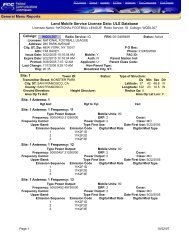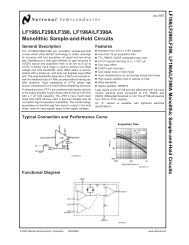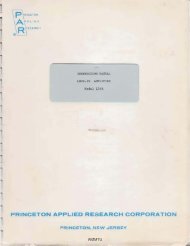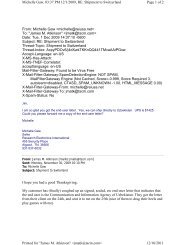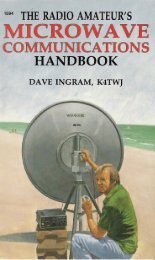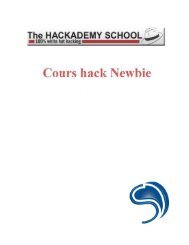A License Plate Recognition and Speed Detection System - Index of
A License Plate Recognition and Speed Detection System - Index of
A License Plate Recognition and Speed Detection System - Index of
Create successful ePaper yourself
Turn your PDF publications into a flip-book with our unique Google optimized e-Paper software.
we set pins 8 to 15 as input pins <strong>and</strong> pause the program for 200 milliseconds. This pause time<br />
was chosen because it is somewhat longer than the cycling time <strong>of</strong> the BCD counter, which<br />
requires ~143 milliseconds to update itself. After pausing, the DEBUG routine sends the value<br />
on each input pin out the serial port to the laptop via an RS232 connection. The value on pin 15<br />
represents the most significant bit <strong>and</strong> the value on pin 8 represents the least significant bit in the<br />
Binary Coded Decimal. The laptop computer takes this binary input <strong>and</strong> converts it back to the<br />
decimal value <strong>of</strong> the vehicle’s speed.<br />
When the Ramsey kit was assembled, we used IC sockets to mount the IC chips instead<br />
<strong>of</strong> soldering them directly to the printed circuit board. This allowed us to solder the ribbon cable<br />
to the BCD counter chip without having to worry about damaging the chip (or any other chip<br />
during assembly). In testing the Radar Gun – BasicStamp combination, it was noticed that the<br />
digital readout on the Radar Gun went blank, which meant we did not have an independent<br />
confirmation <strong>of</strong> the vehicle’s speed. The problem appeared to be caused by too large a drain at<br />
the BasicStamp connection. To remedy the problem, we first unsoldered the ribbon cable from<br />
the Readout’s BCD output pins. Then we purchased a second dual BCD decade counter <strong>and</strong><br />
mounted it on the HomeWork module’s breadboard. Next, the input signal was taken from the<br />
Readout’s Quad NAND gate IC chip at pin 11. The second BCD counter was wired on the<br />
breadboard exactly as the one on the Readout’s circuit board, except it draws power directly<br />
from the lantern batteries <strong>and</strong> the second BCD’s output pins were now connected to the<br />
HomeWork board’s input pins.<br />
51





